View Full Report – 2023 Annual Report – Sustained Strength, Sustained Solutions
Tag: Infrastructure
White House Seeks to Speed Up Infrastructure Implementation

A White House “Accelerating Infrastructure Summit” on Oct. 13 showcased actions by the administration to hasten infrastructure project construction by improving coordination with mayors and governors. (Summit video and White House Action Plan)
Accelerating IIJA Investment
- Mitch Landrieu, the White House’s infrastructure coordinator (photo above) stated, “With over 90% of Bipartisan Infrastructure Law funding being delivered by non-federal agencies, our state, tribal, regional, territorial, local and industry partners must also find ways to accelerate the delivery of infrastructure.” (ABC News, Oct. 13)
- The plan—funded under the $1.2 trillion bipartisan Infrastructure Investment and Jobs Act (IIJA) enacted last November and supplemented by the Inflation Reduction Act in August—is the most significant investment in infrastructure since the interstate highway initiative during the Eisenhower administration. The Roundtable strongly backed the IIJA as it moved through the legislative process. (Roundtable Weekly, Nov. 12, 2021)
- The IIJA broadens access to federal funding programs by targeting resources toward communities. The administration launched a webpage on Grants.gov and a Technical Assistance Guide to help communities with infrastructure project resources, from grant writing to funding eligibility requirements. A web-based interactive map also shows where IIJA funds have been disbursed in communities across the nation.
On Time, On Task, and On Budget
- The White House acceleration plan details numerous federal policy initiatives and complements the administration’s Permitting Action Plan, released in May. (Transportation Today, Oct. 17)
The Roundtable continues to support federal transportation infrastructure investments to spur economic growth, support local communities, and enhance America’s competitiveness. (Roundtable Weekly, May 20 and Roundtable’s 2022 Policy Agenda)
# # #
Senate Democrats Strike Deal to Speed-Up Federal Permits for Major Energy Projects
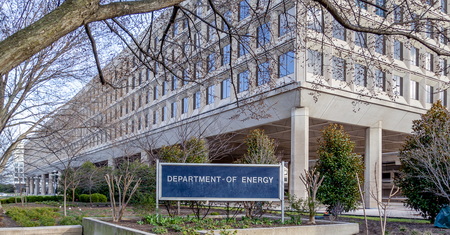
Sen. Joe Manchin (D-WV) and Democratic Senate leadership reached a side deal on federal energy permitting this week, separate from the larger reconciliation bill agreement addressing climate, taxes, and drug pricing reform. (PoliticoPro, One-page summary of agreement and Washington Post, Aug. 1)
Energy Permitting Provisions
- An outline of the energy permitting agreement shows that an eventual bill would direct the President to designate and periodically update a list of at least 25 high-priority energy infrastructure projects and prioritize their approvals by federal agencies.
- The agreement could lead to policies that accelerate federal approvals for long-distance transmission lines needed to help “clean the grid” and deliver renewable energy generated in rural areas to cities.
- The agreement would also limit National Environmental Policy Act (NEPA) reviews for major federal projects to two years, and one year for lower-impact projects. NEPA requires federal agencies to assess alternatives to their proposed actions that have lesser environmental impacts. (EPA fact sheet)
- The Democratic senators agreed with House Speaker Nancy Pelosi (D-CA) that the permitting agreement could be added to a stopgap spending measure to fund the government after Sept. 30. (BGov, Aug. 3)
- In May, the Biden administration released a Permitting Action Plan to strengthen and accelerate Federal permitting and environmental reviews. Another package of White House changes to permitting rules is expected later this year. (Roundtable Weekly, April 22 | White House news release, May 11 | BGov, Aug. 4).
Climate Financial Risk Tool

- The Treasury Department launched its Climate Data and Analytics Hub pilot, which aims to provide regulators with data, software and tools to gauge climate change risk to the financial system. (Treasury Department Fact Sheet)
Initial access to the pilot will be limited to the Federal Reserve Board of Governors (FRB) and the Federal Reserve Bank of New York (FRBNY), with the goal of expanding access to all of the Financial Stability Oversight Council (FSOC) member agencies.
# # #
2022 Annual Report – Building a More Resilient and Dynamic Future
Biden Administration Marks Six-Month Anniversary of Bipartisan Infrastructure Law
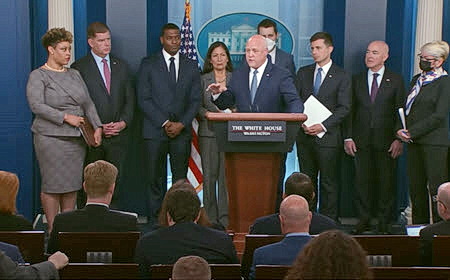
White House Infrastructure Coordinator Mitch Landrieu led a group of Biden administration cabinet officials this week in recognizing the six-month anniversary of the $1 trillion infrastructure package, noting the 4,300 projects underway with more than $110 billion in allocated funding. (White House Fact Sheet and YouTube news conference, May 16)
Implementation Efforts
- The Biden Administration has published an interactive map showing where the $110 billion will be spent. Of that total amount, $52.5 billion is for federal highway funding this fiscal year, $20.5 billion for public transit, and $27 billion over five years for bridges, airports, ports, the electric grid, and other infrastructure programs.
- Ninety percent of funding authorized by the $1.2 trillion Infrastructure Investment and Jobs Act (IIJA) enacted last November will be implemented by governors and mayors. In January, the White House requested state and local leaders appoint infrastructure coordinators to manage the flow of funds. (White House Fact Sheet, May 16)
- A White House guidebook to IIJA-funded programs released on Jan. 31 provides a key tool for states and local governments to apply for federal grants, loans, and public-private partnership resources under more than 375 infrastructure investment programs. (The Hill, Jan. 31 and Roundtable Weekly, Feb. 4)
- Department of Transportation (DOT) Secretary Pete Buttigieg stated on March 28 that the administration’s budget includes $100 million in recommended funding for the Hudson Tunnel commuter rail project, which is part of the Gateway Program, a series of strategic rail infrastructure investments along the Northeast Corridor. (Railway Age, March 29 and The Center Square, March 30)
Roundtable Support
- The Roundtable has long supported federal transportation infrastructure investments to spur economic growth, support local communities and enhance America’s competitiveness. (Roundtable Weekly, Nov. 12, 2021)
- The Roundtable’s 2022 Policy Agenda states, “The IIJA allows $550 billion in new infrastructure investments, estimated to create around 2 million jobs per year over the next decade. This long-term investment in physical infrastructure can re-imagine how we can productively move people, goods, power and information from home to work, business to business, community to community – and building to building.”
Landrieu noted that many large infrastructure projects funded by the law will take years to build out. “This is going to be Infrastructure Decade,” he said. (Reuters, May 16)
# # #
White House Releases Plans to Battle Inflation and Streamline Infrastructure Permitting; Congressional Leaders Urge Swift Implementation of New EB-5 Law
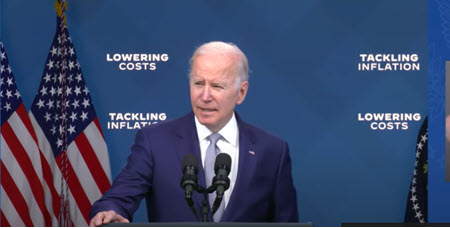

President Joe Biden this week committed that his administration’s top economic priority is battling inflation. Biden’s efforts to combat rising prices include proposals that would increase taxes on large corporations and the wealthiest Americans – and possibly eliminate Trump-era tariffs on foreign imports. (White House Inflation Plan | News conference video | The Hill, May 10)
- The Labor Department reported that consumer prices increased 8.3% in April compared to one year ago, as inflation remains near a four-decade high. (Labor Department news release and AP, May 11)
- Federal Reserve Chair Jerome Powell discussed the Fed’s inflationary goals during an interview this week with Marketwatch, stating, “Whether we can execute a soft landing or not, it may actually depend on factors that we don’t control.” The Fed recently approved the biggest interest hike in 22 years and announced plans for reducing its nearly $9 trillion balance sheet. (CNBC, May 12)
- Powell also recently stated, “There is a broad sense on the committee that additional 50 basis point increases should be on the table at the next couple of meetings.” He added, “the American economy is very strong, and well-positioned to handle tighter monetary policy.” (Wall Street Journal, May 4)
- A semi-annual report released this week by the Fed detailed risks to financial stability, pointing to the potential impact of inflation, sharply rising interest rates and the war in Ukraine. The report also flagged a decline in liquidity. “While the recent deterioration in liquidity has not been as extreme as in some past episodes, the risk of a sudden significant deterioration appears higher than normal,” according to the report. (Wall Street Journal, May 9)
- Powell was approved this week to serve a second term as Fed Chair by a bipartisan Senate vote of 80-19. (Politico, May 12)
Infrastructure Permitting

- The White House this week also unveiled a plan to strengthen and accelerate federal permitting and environmental reviews funded by the Infrastructure Investment and Jobs Act (IIJA) passed last November. (White House Fact Sheet, May 11 and Roundtable Weekly, Nov. 12, 2021)
- The Biden administration said its Permitting Action Plan will improve environmental reviews to avoid duplicity and will create sector-specific teams aimed at speeding permitting and resolve supply chain issues that hinder construction.
EB-5 Regional Centers

- Four congressional leaders wrote a bipartisan letter to Homeland Security Secretary Alejandro Mayorkas this week to counter a statement by the U.S. Citizenship and Immigration Services that existing EB-5 regional centers must apply for recertification. The USCIS statement, if put into effect, would delay regional center enterprises from seeking new foreign investment pending reapproval. (Congressional letter, May 9)
- The letter was signed by Senate Majority Leader Chuck Schumer (D-NY), House Judiciary Committee Chair Jerrold Nadler (D-NY), and Senate Judiciary Committee members John Cornyn (R-TX) and Lindsey Graham (R-SC).
- Their letter clarified that previously existing regional centers are not required to be recertified under the EB-5 Reform and Integrity Act of 2022 passed last March – but the centers must swiftly meet all of the new law’s anti-fraud and homeland security protections. (EB-5 investors blog, May 10)
- USCIS’s position is also the subject of a pending legal challenge in California federal trial court. (Behring Regional Center LLC v. Mayorkas)
The Roundtable-supported EB-5 Reform and Integrity Act was the first significant update to the regional center program since its creation by Congress in the early 1990s. (Roundtable Weekly, March 11, Roundtable news release and EB-5 Fact Sheet)
# # #
Biden Administration Issues Rules Affecting Environmental Approval and Sourcing of Major Infrastructure Projects

The Biden administration announced this week the restoration of strict environmental reviews for major infrastructure projects. Additionally, the U.S. Office of Management and Budget (OMB) issued new guidance to help federal agencies implement the “Build America, Buy America” sourcing provisions passed as part of the Infrastructure Investment and Jobs Act (IIJA) last November. (PoliticoPro and Council on Environmental Quality, April 19)
Project Permitting & Climate Change
- The environmental guidelines will revive how federal agencies authorize and issue permits for infrastructure construction projects. The regulations reaffirm that Federal agencies must evaluate all environmental impacts – including those associated with climate change – during reviews of proposed projects like bridges, mass transit and energy generation. (Wall Street Journal, April 19)
- A second, broader proposal with additional changes is expected later this year. It is uncertain how the regulatory review guidance will affect projects authorized in the Roundtable-supported $1 trillion IIJA. (White House Council on Environmental Quality, April 19, 2022 and Roundtable Weekly, Nov. 12, 2021)
- The restored regulations, which take effect on May 20, will also allow federal agencies to adopt environmental review standards that are more stringent than what is outlined in the National Environmental Policy Act (NEPA). The NEPA environmental review rules were in effect since 1970 before the Trump administration scaled them back in 2020. (Reuters, July 15, 2020)
- Under Trump’s revisions, full environmental-impact statements were required to be completed within two years, while less comprehensive reviews had a one-year deadline. (Wall Street Journal, July 15, 2020)
Infrastructure Materials Sourced in America

- The OMB’s preliminary guidance issued this week instructs federal agencies how to implement new “Buy America” requirements applicable to federally funded infrastructure projects. (Associated Press, April 18)
- The IIJA requirement provision mandates that all federal agencies must ensure that a “Buy America” requirement applies to all infrastructure projects that receive federal financial assistance, whether or not funded through IIJA. (National Law Review Q&A, April 20)
- The new requirements, which take effect on May 14, require material purchased for infrastructure projects be produced in the U.S, with waivers included in case there are either not enough U.S. producers or domestic material costs prove excessive. (White House blog, April 20)
The Biden administration’s effort to increase domestic manufacturing and ease supply chain pressures from overseas sourcing comes as inflation has reached a 40-year high ahead of the 2022 midterm elections. (U.S. Bureau of Labor Statistics, April 12)
# # #
Federal Aid Flowing to Transportation Infrastructure Projects, Including NY-NJ Gateway Program
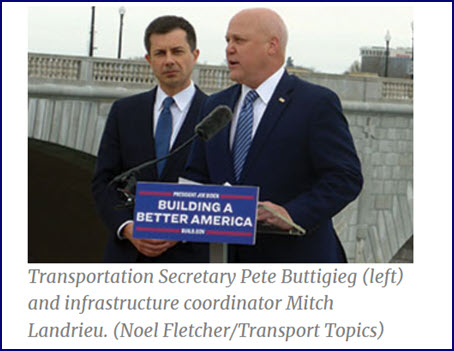

Department of Transportation (DOT) Secretary Pete Buttigieg and White House Infrastructure Coordinator Mitch Landrieu on March 24 announced $2.9 billion in combined funding under a new infrastructure grant program. The new “Multimodal Projects Discretionary Grant” will allow all communities pursuing major transportation infrastructure projects to submit one application for three major DOT funding sources. (DOT Twitter, March 23)
Surface Transportation Funding Expansion
- DOT funds under the new program will be awarded on a competitive basis for surface transportation infrastructure projects that have significant national or regional impact, according to DOT’s March 22 Notice of Funding Opportunity. (Transport Topics, March 24)
- Secretary Buttigieg said he expects to announce winners by the fall after receiving final applications by May 23. (Washington Post, March 23 and DOT Notice of Funding Opportunity)
- Last November, the enactment of the $1.2 trillion Infrastructure Investment and Jobs Act (IIJA) includes more than $350 billion over five fiscal years for surface transportation programs. (DOT news release, Jan. 14)
- White House Infrastructure Chief Landrieu said about half of the IIJA’s $1.2 trillion will flow through the DOT during a presentation earlier this month at a Bipartisan Policy Center virtual forum. (Engineering News-Record, March 9)
- This week, an additional $105 billion for the DOT was included in President Biden’s FY2023 budget request (see story above). The combined funding sources are expected to expand DOT’s discretionary grant programs for large, complex infrastructure projects that may involve more than one state. (DOT FY23 Budget Highlights document)
Gateway Project & IIJA
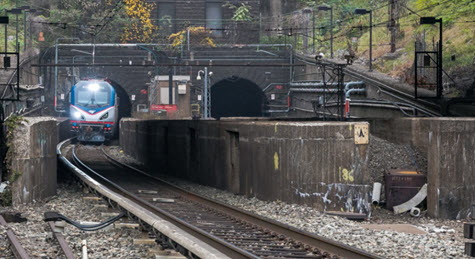
- A March 28 announcement by DOT Secretary Buttigieg stated that the Administration’s budget recommends $4.45 billion to advance 15 major transit projects in FY2023. “This includes, for the first time, $100 million in recommended funding for the Hudson Tunnel commuter rail project, which is part of the Gateway Program, a series of strategic rail infrastructure investments along the Northeast Corridor.” (Railway Age, March 29 and The Center Square, March 30)
- The Roundtable has long supported federal transportation infrastructure investments to spur economic growth, support local communities and enhance America’s competitiveness. (Roundtable Weekly, Nov. 12, 2021)
- The Roundtable’s 2022 Policy Agenda states, “The IIJA allows $550 billion in new infrastructure investments, estimated to create around 2 million jobs per year over the next decade. This long-term investment in physical infrastructure can re-imagine how we can productively move people, goods, power and information from home to work, business to business, community to community – and building to building.”
A guidebook to IIJA funding programs released on Jan. 31 provides a key tool for states and local governments to apply for federal grants, loans, and public-private partnership resources under more than 375 infrastructure investment programs. (The Hill, Jan. 31 and Roundtable Weekly, Feb. 4)
# # #
FCC Issues New Rule That May Hinder Broadband Deployment in Multi-Tenant Buildings


A Federal Communications Commission (FCC) order released Tuesday aims to nullify arrangements between broadband providers and building owners to deliver efficient and cost effective internet service for residential and business tenants. (Bloomberg, Feb. 15)
- The FCC maintains that its latest rules will “unblock broadband competition” for apartment dwellers and businesses. The agency aims to block agreements that would allow building owners to share revenue with a broadband company when providing internet access in a residential or commercial building. (FCC news release)
- The FCC’s action this week derives from a Biden Administration executive order issued last summer that contains a far-reaching objective to “promote competition in the American economy.” The order included a lone reference to rules that improve tenants’ choices in selecting broadband providers, which led to this week’s action by the FCC.
- Multifamily industry advocates counter that the FCC’s latest order could “discourage investment and harm deployment and maintenance of broadband networks.” [Feb. 17 statement of the National Multifamily Housing Council (NMHC) and the National Apartment Association (NAA)]
- The NMHC and NAA statement explains that the FCC’s ruling attempts to provide a solution where there is no problem. “Industry data shows competition and superior broadband service already exists, with 80 percent of apartments surveyed having two or more providers on site.”
- NMHC and NAA also point out that the FCC’s order could actually hinder broadband access for Americans living in low-income communities, smaller rentals, public housing, and other underserved properties most in need of broadband modernization. “Building owners often struggle to find even one provider to serve a property and provide up-to-date broadband service in these locations,” the organizations stated.

- NMHC and NAA led a coalition of real estate groups – including The Real Estate Roundtable and Nareit – in filing comments to the FCC last fall. The coalition comments demonstrated there is “ample competition in the broadband market in apartment buildings and office and retail properties” and that new FCC rules were unnecessary.
- The real estate coalition comments also explained that “revenue sharing agreements” between building owners and broadband providers are not the problem that limits internet access in low-income and other underserved communities. Rather, the chief “limiting factor” in addressing that challenge is the cost of “extending infrastructure to and within those communities” in the first place. (FCC comment letter, Oct. 20, 2021)
The bipartisan Infrastructure Investment and Jobs Act (IIJA) invests roughly $65 billion “to help ensure that every American has access to reliable high speed internet.” (Bipartisan Infrastructure Law Guidebook, “Broadband” section)
The Roundtable will continue to work with coalition partners to promote speedy and proper disbursement of IIJA funds for broadband and other infrastructure projects, while preserving the rights of owners to manage their buildings and meet their tenants’ demands.
# # #
Policymakers Focus on Federal Infrastructure Spending
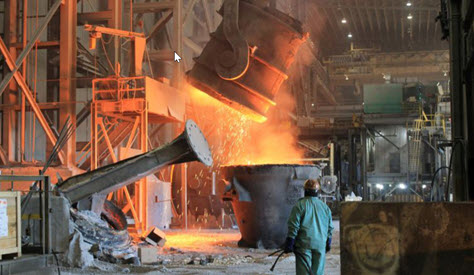

Washington policymakers this week addressed new initiatives to disburse $1.2 trillion in federal infrastructure investment, including agency spending that will support production of low-carbon construction materials. (White House Fact Sheet, Feb. 15)
Biden Administration Efforts
- President Biden yesterday traveled to Ohio to emphasize how the Infrastructure Investment and Jobs Act (IIJA) signed into law last November is funding new roads, bridges and railways while also protecting the environment. (Roundtable Weekly, Nov. 12, 2021 and Reuters, Jan. 17)
- The White House on Tuesday announced new government-wide actions to support clean manufacturing for low-carbon production of steel, aluminum, and concrete needed as materials for electric vehicles, solar panels, buildings, and transportation projects.
- A “Buy Clean Task Force” includes efforts by the General Services Administration (GSA) to encourage best practices for reducing “embodied emissions” of construction materials in federal buildings. (Reuters and MarketWatch, Feb. 15)
- The administration also launched “Infrastructure School” this week – a series of webinars to provide an in-depth look into IIJA investment categories ranging from roads to rail to mass transit to broadband. Each webinar will cover an infrastructure asset class described in the Administration’s recently released Bipartisan Infrastructure Law guidebook. (Usetinc, Feb. 15 and Roundtable Weekly, Feb. 4)
Transportation Spending Controversies

- Billions from the Infrastructure Investment and Jobs Act (IIJA) for transportation projects are on hold, dependent on Congress reaching a deal on an “omnibus” appropriations bill to fund the U.S. government though Sept. 30. Meanwhile, the types of highways projects that should primarily benefit from federal funding is becoming a contentious issue. (E&E News, Feb. 7 and BGov, Feb.9)
- The Biden Administration in December issued guidance advising states to prioritize IIJA transportation dollars for maintaining and improving existing highways – before adding new lanes.
- In a letter last month to President Biden, a group of 16 Republican governors asked for greater flexibility. The letter noted, “A clear example of federal overreach would be an attempt by the Federal Highway Administration to limit state widening projects.”
- Senate Minority Leader Mitch McConnell (R-KY) and Sen. Shelley Moore Capito (R-WV) last week countered the Biden Administration’s guidance. They advised U.S. governors that the IIJA has no authority to “dictate how states should use their federal formula funding, nor prioritizes public transit or bike paths over new roads and bridges.” (Wall Street Journal, Feb. 9)
- Additionally, the Biden administration on Feb. 10 released a plan to distribute $5 billion in formula funding to states for EV chargers. States would first have to present charging network “deployment plans” to the US-DOT before receiving federal money. (CNBC, Feb. 10)
- In Congress, the economic impact of infrastructure investing was the focus of a Tuesday hearing held by a House Ways and Means subcommittee. (W&M news release, Feb. 5)
Transit industry experts, state transportation officials, and other witnesses testified before the subcommittee on the importance of the IIJA’s funding to transportation infrastructure improvements, economic growth and public health.
# # #

